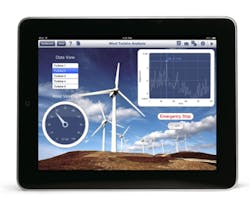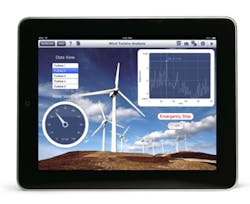The increasing capabilities of wireless consumer-electronics mobile devices are opening up new possibilities for remote monitoring and control in data-acquisition systems. Applications range from machine-condition monitoring to telemedicine and related mobile health (mHealth) initiatives.
Grant Heimbach, LabVIEW product manager at National Instruments, said in a recent phone interview, “’Mobile’ is a big driver. We see a large increase in customers asking about remote monitoring. They have [DAQ and control] systems now and ask, ‘How can I view my data from home? How can I monitor and control a process from home, across the hall, across the campus, or around the world?’ Customers want remote access to systems.”
Heimbach recently completed a chapter on mobility for the National Instruments 2013 report on DAQ technology.1 In that report, he noted, “In the data-acquisition space, engineers are using mobile technologies with constant access to information to achieve efficiency gains and in many cases avoid issues before they become costly problems.” Nevertheless, he wrote, “Mobile technology is evolving quickly, which makes implementation and setting standards difficult. To capitalize, engineers and scientists must evolve their skill sets by understanding options for mobile integration and keeping tabs on the outlook for future mobile systems.”
Heimbach elaborated during the phone interview on National Instruments’ initiatives to address customers’ requirements and help them evolve their skill sets: “For four or five years, we have been working on solutions based on open standards, maintaining insight into consumer trends.”
Efforts have focused on the iOS and Android platforms, he said, but the consumer market shifts rapidly. He noted that he is seeing growing interest in the Widows 8 operating system and particularly in Microsoft’s Surface Pro, a tablet-like device based on the Intel x86 architecture that can run full versions of programs like NI LabVIEW and Adobe PhotoShop.
Nevertheless, users looking for remote monitoring and control often are interested in lighter weight and longer battery life than offered by a device like the Surface Pro. For such users, NI offers apps for iOS and Android phones and tablets as well as Windows 8 running on the Surface RT, an ARM-based mobile device that won’t run full versions of programs like LabVIEW that require an x86-based processor.
Data Dashboard for LabVIEW runs on an iPad, Android tablet, or Windows 8 tablet while Data Dashboard Mobile for LabVIEW uses an iPhone, an Android phone, or a device running the Windows Phone operating system. In addition, the NI cDAQ-9191 data display enables users to wirelessly take voltage measurements from an NI cDAQ-9191 chassis with an NI 9215 C Series measurement module using an iOS or Android device.
NI cites machine monitoring and control as a key application for smartphone- and tablet-based measurements in which the mobile device serves as the human-machine interface (HMI). Continual monitoring by the smart devices can generate alerts when machine maintenance is required, avoiding equipment failures and excessive downtimes.2
Heimbach said that when designing apps such as the Data Dashboard, ease of use is the key. “We cater to engineers and scientists who are not app developers,” he said. “We do the heavy lifting to give them access to full functionality.” The Data Dashboard app presents a freeform canvas that users can populate with gages, knobs, and graphs as appropriate for their applications (Figure 1) without having to program in a low-level language.
Figure 1. Data Dashboard for LabVIEW Monitoring Wind Turbines on an iPad
Courtesy of National Instruments
A key issue when designing a remote HMI is how to establish communications. Heimbach recommended using web services,3 which, when implemented between the mobile device and the measurement system called, return human-readable responses.
Security also is a critical issue that must be addressed when considering a remote-monitoring application based on a consumer mobile device. Someone with the persistence of the Stuxnet worm developers would be hard to guard against. Nevertheless, Heimbach said NI will work with customers to determine how to mitigate security risks. He suggested using web services in conjunction with SSL (Secure Socket Layer) and TLS (Transport Layer Security). And in addition to requiring a password to log in to the VPN to which a mobile device connects, a password could be required to access each application. Finally, he said, it’s advisable to provide a method to remotely wipe the device should it be lost or stolen.
Heimbach predicted that test and measurement systems will continue to evolve into a more networked state as GPIB instruments are replaced with Ethernet versions. Mobile access, he said, will become a primary requirement in a variety of industries ranging from aerospace to medical electronics.
Mobile Health Initiatives
Medical electronics was the specific focus of Bill Betten, medical technology director at TechInsights, as he delivered a keynote address titled “When Worlds Collide–Medical Devices Meet Consumer Technology” to attendees of Electronics New England and the co-located BIOMEDevice event in April in Boston.
Despite a history of significant differences, the former vice president of engineering at a medical device company said, consumer electronics products and medical devices are converging.
Betten is in a position to know because his firm, an IP professional services company with a 20-year history of tearing down consumer products, has performed teardowns of more than 50 medical devices over the past two years. Betten described the traditional gaps that have appeared between medical and consumer products, extending from development philosophies to the regulatory environment. For example, consumer devices are designed quickly with manufacturers facing pressure to keep prices low. The medical-device community traditionally faces longer design cycles and less price sensitivity.
Nevertheless, the need for low-cost medical devices is becoming increasingly important as aging populations face an increase in chronic disease. As an example, Betten provided data from the International Diabetes Association showing that in 2011 the number of people worldwide living with diabetes was 366 million—a figure estimated to increase to 552 million by 2030 if urgent action is not taken.4
Indicating the importance of mobile connectivity in emerging health initiatives, Betten cited a recent World Health Organization report5 on the global adoption of mHealth initiatives. In that report, mobile telemedicine ranked fourth after health call center operations, toll-free emergency calls, and disaster and emergency management but before appointment reminders, community mobilization efforts, treatment compliance efforts, patient record keeping, health surveys, awareness raising, and other activities.
The report defined mobile telemedicine as “the communication or consultation between health professionals about patients using the voice, text, data, imaging, or video functions of a mobile device. But it can be applied to other situations; the management of chronic diseases of patients living at home is one example.” In addition, the report said, mobile technologies can help address challenges related to human-resources shortages and underserved areas in developing countries by connecting patients, community health workers, and physicians to improve quality of care at the point of care and reduce unnecessary referrals.
Consumer mobile technology, Betten said in his keynote address, has increased in capability to the point where it has a role to play in monitoring and treatment products that can, for example, let a patient move from a $10,000 per day intensive-care unit to a much less expensive assisted living facility. Such products, he said, need to be small, portable, and easy to use. And most significantly, they must be connected to enable remote monitoring—often via the data cloud—by trusted, trained experts.
As an example of the importance wireless connectivity can play in healthcare, Betten cited the GSMA’s mHealth program, which enlists mobile operators, governments, healthcare providers, funders, and end users to improve health outcomes in emerging markets. (GSMA originally was known as the Groupe Speciale Mobile, or GSM, Association.)
Betten cited several products that exemplify the closing gap between consumer electronics and medical devices. The iOS-compatible Withings blood-pressure monitor, for example, lets you email your measurement history to your doctor using your iPhone or iPad. In addition, you can synchronize your measurements with Microsoft HealthVault. And the AliveCor heart monitor, which snaps onto an iPhone 4 or 4S, can record, display, store, and transfer single-channel electrocardiogram rhythms.
Betten also cited the AirStrip Technologies mobile-technology platform that supports enhanced communications of patient information. In January, the company announced that labor and delivery teams using its AirStrip OB have delivered more than 1.4 million babies since the initial deployment in 2006, adding that of the total, more than 2,400 at-risk deliveries have been positively impacted.
Airstrip Technologies launched AirStrip ONE in February, which will initially be implemented at Dignity Health (a San Francisco-based health system with more than 300 care sites in 17 states) as the first enterprise-wide, data- and vendor-agnostic mobility solution to securely deliver patient data from medical devices, electronic medical records, and patient monitors to clinicians anywhere across the care continuum.
And, in March, AirStrip announced that it has engaged in a partnership agreement with Philips to utilize AirStrip’s clinical mobility solutions to connect to Philips IntelliVue Information Center, a real-time central monitoring system that offers clinicians easy access to information.
Near the conclusion of his keynote address, Betten presented a bell curve, with medical device manufacturers occupying one tail while consumer electronics makers occupy the other. The later group pursues low costs, less-than-one-year development cycles, open-source software, moderate reliability and security, and volumes in the millions.
The medical companies, on the other hand, find less price sensitivity. They pursue differentiation through proprietary software, experience three- to five-year development cycles, require high reliability, maintain security in accordance with HIPAA patient privacy mandates, and reach volumes of about 1,000 to 1 million units per year. He added that 2.8 million hearing aides were sold in the United States last year, calling that a huge number for a class of medical devices.
But, Betten concluded, while some manufacturers will operate at the bell-curve tails, there is a huge battleground in the middle in which both medical and consumer manufacturers will participate. “Convergence,” he said, “is changing both worlds.”
Conclusion
As consumer devices continue to make inroads into remote-monitoring and DAQ applications, engineers will face new challenges. In National Instruments’ Data Acquisition Outlook 2013, a chapter on big data explained, “There was once a time when hardware sampling rates…physically restricted how much data was acquired. But today, hardware vendors have accelerated data collection rates so quickly and enabled engineers and scientists to break through rate and resolution barriers so rapidly that they have ultimately triggered a new wave of data consequences.” As a result, “Differentiation is no longer about who can collect the most data; it’s about who can quickly make sense of the data they collect.”6
Betten summed up the problem this way in his keynote address at BIOMEDevice and Electronics New England: Given the prevalence of home health monitoring capability, some consumers, whom he called the “quants,” monitor everything—diet, heart rate, blood pressure, and so on—and they blog about it and otherwise stream endless information onto the Internet. In essence, they generate much more data than their healthcare providers could possibly make use of. This unceasing stream of data, Betten said, constitutes noise, not signal. As sensors deliver more and more data to the cloud, he said, the challenge will be to mine that data and make it relevant.
References
1. “Mobile Technology’s Influence on Data Acquisition,” Data Acquisition Technology Outlook 2013, National Instruments, 2013, p. 16.
2. “Smartphones and Tablets for Measurement and Control,” NI News, National Instruments, April 3, 2013.
3. “Web Services Activity,” Technology & Society Domain, World Wide Web Consortium.
4. “Diabetes Landscape: Market, Technology, and Intellectual Property,” Research Report Summary, TechInsights and Espicom, 2012.
5. “mHealth: New horizons for health through mobile technologies,” Global Observatory for eHealth series—Volume 3, World Health Organization, 2011.
6. “Big Analog Data and Data Acquisition,” Data Acquisition Technology Outlook 2013, National Instruments, 2013, p. 4.

